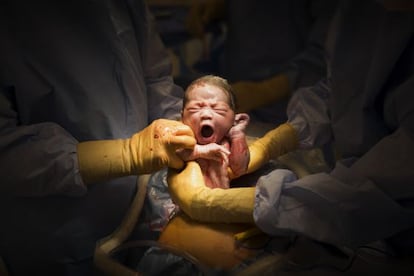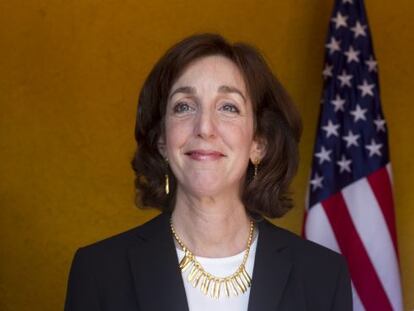Half of Mexican babies now born by C-section procedures
Caesareans are a growing national trend, despite the WHO’s warnings of risks


Ana Luisa Torres knew she picked the right gynecologist when she called him on a Sunday to ask a question. “He said he had little time to talk because he was in the middle of delivering a baby. It was a Sunday so that put me at ease,” she recalls.
There are fewer children being born on a Sunday in Mexico these days. Of all the babies born, about half come into the world by Caesarean section, and ideally these procedures are scheduled Monday through Friday.
Despite all the recommendations against the procedures by the World Health Organization (WHO), C-sections are on the rise across Mexico. A woman’s body is naturally prepared for giving birth and Caesareans only raise the risk of complications, health experts claim. The possibility of a mother ending up in intensive care (ICU) is 10 times greater when a Caesarean is performed as opposed to a normal vaginal delivery, according to the WHO.
Yet despite the warnings from many global health organizations, the figures for C-section procedures in Mexico are growing rapidly.
The chance of ending up in intensive care is 10 times greater with a Caesarean
At the private hospital Médica Sur in Mexico City, 75 out of 100 mothers never become aware that they have gone through labor. No deep huffs and puffs or agonizing pushing is needed; babies are born quickly and more painlessly.
Caesareans are not only taking place at private clinics but also in public hospitals. According to the National Survey of Health and Nutrition, 41 percent of infants were delivered by C-sections at public hospitals in 2012 — a figure well above the WHO’s 15-percent global average.
Consumer Power, a Mexican NGO, reports that last year Mexico was the country where the most Caesareans were practiced. According to a recent UNICEF report based on data from 2006 to 2010, Brazil led the ranking of C-section births.
“Today’s gynecologists don’t know how to use instruments when they graduate from school. Even if they can deliver a baby by pelvic birth, they go ahead and perform a Caesarean even though it isn’t necessary,” says Dr Manuel Eduardo Undo, a gynecologist who has been working at Médico Sur for the past 45 years. “There are few of us who still believe that it should be up to the mother to make that choice in how they want to give birth.”
In public hospitals, 41 percent of infants were delivered by C-section in 2012
One factor adding to this growing trend is that doctors also fear they could face the possibility of a malpractice suit if a mother suffers from complications.
“If they see any change in the baby’s heart rate, doctors opt for a Caesarean section even if it is not necessary,” explains Undo.
In Mexico, it is no longer uncommon to hear a pregnant woman say she would prefer a Caesarean over natural labor. Although sometimes it is mothers who opt for surgery because they don’t want to experience the pain, C-sections, although unnecessary, are normally recommended by doctors. But Undo does not defend his colleagues: “They sometimes don’t tell their patients the truth,” he says.
A Caesarean is primarily a time-saving element for most physicians. A mother can go into labor at any time, including on a holiday, and the delivery could take hours, while a Caesarean can be performed in just under an hour.
C-sections save doctors time — one can be performed in just under an hour
Apart from higher health risks, Caesareans also cost more, which leads to more abuses by doctors who insist their patients go through the procedure. For example, a natural birth at a public hospital costs 17,400 pesos (1,000 euros), while the price for a Caesarean is around 21,600 pesos (about 1,300 euros), according to government figures.
But at private hospitals, where more than 15 percent of Mexico’s births take place, the costs are higher. A natural birth can cost 2,000 euros, while C-sections go for about 2,400 euros, and that doesn’t include medical fees.
Most of the time private insurers pick up the bill but Dr Undo — who charges 1,400 euros to perform a Caesarean and 1,000 euros for a natural childbirth — says there are insurers who cover the entire C-section procedure while demanding that the patient pay a deductible if they want their babies born naturally.
“That means that many women prefer having an intervention rather than having to pay,” he says.
Because of time assurances and to save money, Ana Luisa Torres’ friends, her co-workers and one of her sisters opted to go for a Caesarean. But not her. Now in the sixth month of her pregnancy, Ana Luisa says that when the time comes for baby Julian to be born he will come into this world, without any time constraints or fiddling around with the calendar.
Tu suscripción se está usando en otro dispositivo
¿Quieres añadir otro usuario a tu suscripción?
Si continúas leyendo en este dispositivo, no se podrá leer en el otro.
FlechaTu suscripción se está usando en otro dispositivo y solo puedes acceder a EL PAÍS desde un dispositivo a la vez.
Si quieres compartir tu cuenta, cambia tu suscripción a la modalidad Premium, así podrás añadir otro usuario. Cada uno accederá con su propia cuenta de email, lo que os permitirá personalizar vuestra experiencia en EL PAÍS.
¿Tienes una suscripción de empresa? Accede aquí para contratar más cuentas.
En el caso de no saber quién está usando tu cuenta, te recomendamos cambiar tu contraseña aquí.
Si decides continuar compartiendo tu cuenta, este mensaje se mostrará en tu dispositivo y en el de la otra persona que está usando tu cuenta de forma indefinida, afectando a tu experiencia de lectura. Puedes consultar aquí los términos y condiciones de la suscripción digital.
More information

“Cuba is changing”
Urdangarin asked king to lean on sporting figures such as Ecclestone
Últimas noticias
From Andorra to Gibraltar, a black market for Ozempic exploits its success: ‘They’re the most sought-after products in the world’
Magnets in their heads: How some animals guide themselves using the Earth’s magnetic field
From Hungary’s Orbán to Chile’s Kast: How Trump helps turbo charge the far right
The brief rise and retreat of Generation Z in Mexico
Most viewed
- Why we lost the habit of sleeping in two segments and how that changed our sense of time
- Trump’s obsession with putting his name on everything is unprecedented in the United States
- Charles Dubouloz, mountaineering star, retires at 36 with a farewell tour inspired by Walter Bonatti
- The Florida Keys tourist paradise is besieged by immigration agents: ‘We’ve never seen anything like this’
- Living in a motorhome due to soaring housing prices in Madrid: ‘I got used to it quickly, but I don’t idealize it’








































